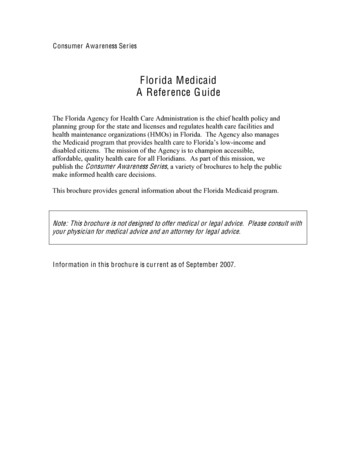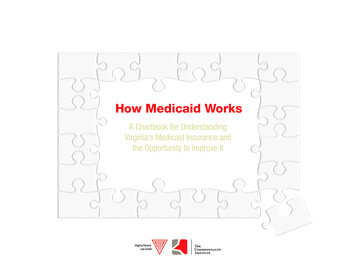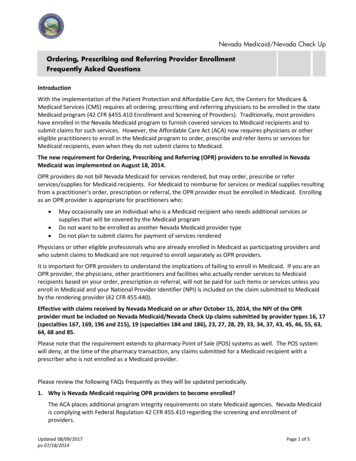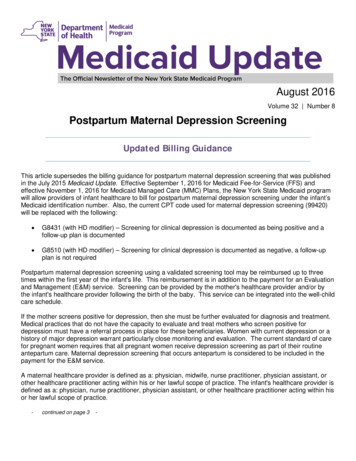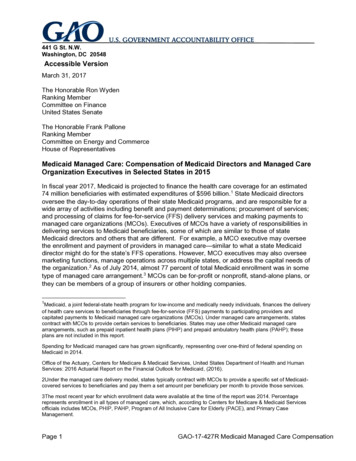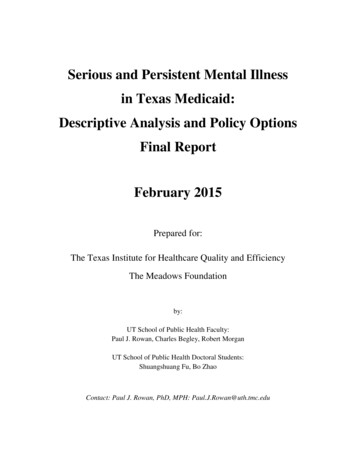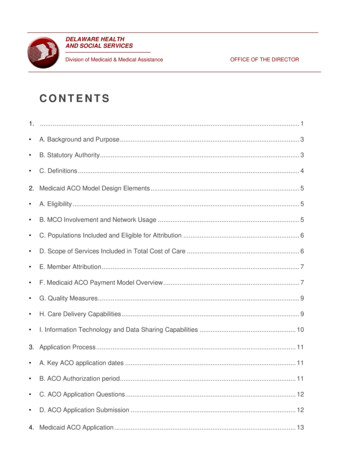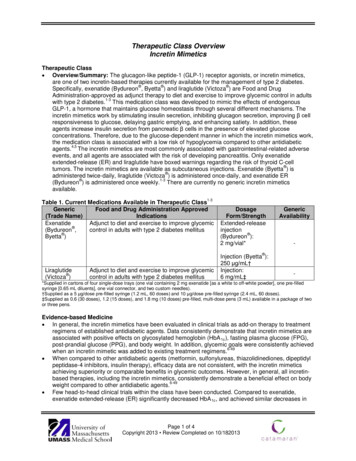
Transcription
Therapeutic Class OverviewIncretin MimeticsTherapeutic Class Overview/Summary: The glucagon-like peptide-1 (GLP-1) receptor agonists, or incretin mimetics,are one of two incretin-based therapies currently available for the management of type 2 diabetes. Specifically, exenatide (Bydureon , Byetta ) and liraglutide (Victoza ) are Food and DrugAdministration-approved as adjunct therapy to diet and exercise to improve glycemic control in adults1-3with type 2 diabetes. This medication class was developed to mimic the effects of endogenousGLP-1, a hormone that maintains glucose homeostasis through several different mechanisms. Theincretin mimetics work by stimulating insulin secretion, inhibiting glucagon secretion, improving β cellresponsiveness to glucose, delaying gastric emptying, and enhancing satiety. In addition, theseagents increase insulin secretion from pancreatic β cells in the presence of elevated glucoseconcentrations. Therefore, due to the glucose-dependent manner in which the incretin mimetics work,the medication class is associated with a low risk of hypoglycemia compared to other antidiabetic4,5agents. The incretin mimetics are most commonly associated with gastrointestinal-related adverseevents, and all agents are associated with the risk of developing pancreatitis. Only exenatideextended-release (ER) and liraglutide have boxed warnings regarding the risk of thyroid C-cell tumors. The incretin mimetics are available as subcutaneous injections. Exenatide (Byetta ) is administered twice-daily, liraglutide (Victoza ) is administered once-daily, and exenatide ER 1-3(Bydureon ) is administered once weekly. There are currently no generic incretin mimeticsavailable.1-3Table 1. Current Medications Available in Therapeutic ClassGenericFood and Drug Administration Approved(Trade Name)IndicationsExenatideAdjunct to diet and exercise to improve glycemic (Bydureon ,control in adults with type 2 diabetes mellitus Byetta )DosageForm/StrengthExtended-releaseinjection (Bydureon ):2 mg/vial*GenericAvailability- Liraglutide (Victoza )Adjunct to diet and exercise to improve glycemiccontrol in adults with type 2 diabetes mellitusInjection (Byetta ):250 μg/mL†Injection:6 mg/mL‡-*Supplied in cartons of four single-dose trays (one vial containing 2 mg exenatide [as a white to off-white powder], one pre-filledsyringe [0.65 mL diluents], one vial connector, and two custom needles).†Supplied as a 5 μg/dose pre-filled syringe (1.2 mL, 60 doses) and 10 μg/dose pre-filled syringe (2.4 mL, 60 doses).‡Supplied as 0.6 (30 doses), 1.2 (15 doses), and 1.8 mg (10 doses) pre-filled, multi-dose pens (3 mL) available in a package of twoor three pens.Evidence-based Medicine In general, the incretin mimetics have been evaluated in clinical trials as add-on therapy to treatmentregimens of established antidiabetic agents. Data consistently demonstrate that incretin mimetics areassociated with positive effects on glycosylated hemoglobin (HbA 1c ), fasting plasma glucose (FPG),post-prandial glucose (PPG), and body weight. In addition, glycemic goals were consistently achieved6-49when an incretin mimetic was added to existing treatment regimens. When compared to other antidiabetic agents (metformin, sulfonylureas, thiazolidinediones, dipeptidylpeptidase-4 inhibitors, insulin therapy), efficacy data are not consistent, with the incretin mimeticsachieving superiority or comparable benefits in glycemic outcomes. However, in general, all incretinbased therapies, including the incretin mimetics, consistently demonstrate a beneficial effect on body6-49weight compared to other antidiabetic agents. Few head-to-head clinical trials within the class have been conducted. Compared to exenatide,exenatide extended-release (ER) significantly decreased HbA 1c , and achieved similar decreases inPage 1 of 4Copyright 2013 Review Completed on 10/182013
Therapeutic Class Overview: incretin mimetics25,31 body weight.In a single trial, liraglutide significantly decreased HbA 1c compared to exenatide.39Furthermore, liraglutide significantly decreased FPG while exenatide significantly decreased PPG.In a 26-week open-label trial, there was a significantly greater reduction from baseline in HbA 1c at 26weeks for patients treated with liraglutide compared to exenatide ER (-0.21%; 95% confidenceinterval [CI], -0.08 to -0.33). In addition, significantly more patients receiving liraglutide achieved anHbA 1c 7% compared to patients treated with exenatide ER (60 vs 53%; P 0.0011). Reductions in32bodyweight also favored treatment with liraglutide (-0.90 kg; 95% CI, -0.39 to -1.40).Overall, safety data demonstrate that incretin mimetics are commonly associated with6-49gastrointestinal-related adverse events. Exenatide ER appears to be associated with less nauseaand vomiting, but more constipation, diarrhea, and injection site-related adverse events compared to25,31exenatide.Key Points within the Medication Class According to Current Clinical Guidelines:50-54o Type 2 diabetes:50-54 Metformin remains the cornerstone to most antidiabetic treatment regimens. Patients with high glycosylated hemoglobin will most likely require combination or50-54triple therapy in order to achieve glycemic goals. The incretin mimetics are recommended as a potential second-line treatment optionto be added to or used in combination with metformin in patients not achieving51,53glycemic goals. A lower rate of hypoglycemia, established efficacy and safety profile whenused in combination with metformin, demonstrated effectiveness in reducingpost-prandial glucose, and the potential for weight loss are noted asadvantages associated with the incretin mimetics compared to other classes51,53of antidiabetic agents.50-54 No one incretin mimetic is recommended or preferred over another. Other Key Facts: 1o Exenatide (Byetta ) is administered twice-daily (60 minutes prior to food). o Exenatide extended-release (ER) (Bydureon ) is administered once weekly (independent of2meals). The extended effect was achieved by adding the biodegradable polymer poly D, Llactic-co-glycolic acid to exenatide. As a result, microspheres are formed and afteradministered, continued infiltration of water into the microspheres causes them to55swell and release exenatide in a slow predictable fashion. Patients who administer exenatide ER will have a palpable subcutaneous nodule at55the injection site that dissipates as the medication is released. 3o Liraglutide (Victoza ) is administered once-daily (independent of meals).o No generic incretin mimetics are available.References1.2.3.4.5.6.7.8.Byetta [package insert]. San Diego (CA): Amylin Pharmaceuticals, Inc.; 2013 Feb.Bydureon [package insert]. San Diego (CA): Amylin Pharmaceuticals, Inc.; 2013 Feb.Victoza [package insert]. Princeton (NJ): Novo Nordisk Inc.; 2013 Apr.Bagger JI, Knop FK, Lund A, Vestergaard H, Holst JJ, Vilsbøll T. Impaired regulation of the incretin effect in patients with type 2diabetes. J Clin Endocrinol Metab. 2011 Mar;96(3):737-45.Drab SR. Clinical studies of liraglutide, a novel, once-daily human glucagon-like peptide-1 analog for improved management oftype 2 diabetes mellitus. Pharmacotherapy. 2009;29(12 Pt 2):S43-54.DeFronzo RA, Ratner RE, Han J, Kim DD, Fineman MS, Baron AD. Effects of exenatide (exendin-4) on glycemic control andweight over 30 weeks in metformin-treated patients with type 2 diabetes. Diabetes Care. 2005 May;28(5):1092-100.Ratner RE, Maggs D, Nielson LL, Stonehouse AH, Poon T, Zhang B, et al. Long-term effects of exenatide therapy over 82weeks on glycemic control and weight in over-weight metformin-treated patients with type 2 diabetes mellitus. Diabetes ObesMetab. 2006 Jul;8(4):419-28.Kendall DM, Riddle MC, Rosenstock J, Zhuang D, Kim DD, Fineman MS, et al. Effects of exenatide (exendin-4) on glycemiccontrol over 30 weeks in patients with type 2 diabetes treated with metformin and a sulfonylurea. Diabetes Care. 2005May;28(5):1083-91.Page 2 of 4Copyright 2013 Review Completed on10/18/2013
Therapeutic Class Overview: incretin 3.24.25.26.27.28.29.30.31.32.33.34.35.36.Buse JB, Henry RR, Han J, Kim DD, Fineman MS, Baron AD. Exenatide-113 Clinical Study Group. Effects of exenatide(exendin-4) on glycemic control over 30 weeks in sulfonylurea-treated patients with type 2 diabetes. Diabetes Care. 2004Nov;27(11):2628-35.Riddle MC, Henry RR, Poon TH, Zhang B, Mac SM, Holcombe JH, et al. Exenatide elicits sustained glycemic control andprogressive reduction of body weight in patients with type 2 diabetes inadequately controlled by sulfonylureas with or withoutmetformin. Diabetes Metab Res Rev. 2006 Nov-Dec;22:483-91.Blonde L, Klein EJ, Han J, Zhang B, Mac SM, Poon TH, et al. Interim analysis of the effects of exenatide treatment on A1C,weight, and cardiovascular risk factors over 82 weeks in 314 overweight patients with type 2 diabetes. Diabetes Obes Metab.2006 Jul;8(4):436-47.Buse JB, Klonoff DC, Nielsen LL, Guan X, Bowlus CL, Holcombe JH, et al. Metabolic effects of two years of exenatidetreatment on diabetes, obesity, and hepatic biomarkers in patients with type 2 diabetes: an interim analysis of data from theopen-label, uncontrolled extension of three double-blind, placebo-controlled trials. Clin Ther. 2007;29(1):139-53.Klonoff DC, Buse JB, Nielsen LL, Guan X, Bowlus CL, Holcombe JH, et al. Exenatide effects on diabetes, obesity,cardiovascular risk factors and hepatic biomarkers in patients with type 2 diabetes treated for at least three years. Curr MedRes Opin. 2008 Jan;24(1):275-86.Viswanathan P, Chaudhuri A, Bhatia R, Al-Atrash F, Mohanty P, Dandona P. Exenatide therapy in obese patients with type 2diabetes mellitus treated with insulin. Endocr Pract. 2007;13:444-50.Zinman B, Hoogwerf BJ, Duran Garcia S, Milton DR, Giaconia JM, Kim DD, et al. The effect of adding exenatide to athiazolidinedione in suboptimally controlled type 2 diabetes. Ann Intern Med. 2007;146:477-85.Buse JB, Bergenstal RM, Glass LC, Heilmann CR, Lewis MS, Kwan AY, et al. Use of twice-daily exenatide in basal insulintreated patients with type 2 diabetes: a randomized, controlled trial. Ann Intern Med. 2011 Jan 18;154(2):103-12.Okerson T, Yan P, Stonehouse A, Brodows R. Effects of exenatide on systolic blood pressure in subjects with type 2 diabetes.Am J Hypertens. 2010;23:334-9.Derosa G, Maffioli P, Salvadeo SAT, Ferrari I, Ragonesi PD, Querci F, et al. Exenatide vs glibenclamide in patients withdiabetes. Diabetes Technol Ther. 2010;12(3):233-40.Heine RJ, Van Gaal LF, Johns D, Mihm MJ, Widel MH, Brodows RG; GWAA Study Group. Exenatide vs insulin glargine inpatients with suboptimally controlled type 2 diabetes: a randomized trial. Ann Intern Med. 2005;143(8):559-69.Secnik Boye K, Matza LS, Oglesby A, Malley K, Kim S, Hayes RP, et al. Patient-reported outcomes in a trial of exenatide andinsulin glargine for the treatment of type 2 diabetes. Health Qual Life Outcomes. 2006 Oct 11;4:80.Davies MJ, Donnelly R, Barnett AH, Jones S, Nicolay C, Kilcoyne A. Exenatide compared to long-acting insulin to achieveglycaemic control with minimal weight gain in patients with type 2 diabetes: results of the Helping Evaluate Exenatide inpatients with diabetes compared to Long-Acting insulin (HEELA) study. Diabetes Obes Metab. 2009 Dec;11(12):1153-62.Bunck MC, Diamant M, Corner A, Eliasson B, Malloy J, Shaginian RM, et al. One-year treatment with exenatide improves βcell function, compared to insulin glargine, in metformin-treated type 2 diabetic patients. Diabetes Care. 2009;32:762-8.Bunck MC, Corner A, Eliasson B, Heine RJ, Shaginian RM, Wu Y, et al. One-year treatment with exenatide vs insulin glargine:effects on postprandial glycemia, lipid profiles, and oxidative stress. Atherosclerosis. 2010 Sep;212(1):223-9.Nauck MA, Duran S, Kim D, Johns D, Northrup J, Festa A, et al. A comparison of twice-daily exenatide and biphasic insulinaspart in patients with type 2 diabetes who were suboptimally controlled with sulfonylurea and metformin: a non-inferioritystudy. Diabetologia. 2007;50(2):259-67.Drucker D, Buse JB, Taylor K, Kendall DM, Trautmann M, Zhuang D, et al. Exenatide once weekly vs twice daily for thetreatment of type 2 diabetes: a randomized, open-label, non-inferiority study. Lancet. 2008;372:1240-50.Buse JB, Drucker DJ, Taylor KL, Kim T, Walsh B, Hu H, et al. DURATION-1: exenatide once weekly produces sustainedglycemic control and weight loss over 52 weeks. Diabetes Care. 2010;33:1255-61.Bergenstal RM, Wysham C, MacConell L, Malloy J, Walsh B, Yan P, et al. Efficacy and safety of exenatide once weekly vssitagliptin or pioglitazone as an adjunct to metformin for treatment of type 2 diabetes (DURATION-2): a randomised trial.Lancet. 2010;376:431-9.Wysham C, Bergenstal R, Malloy J, Yan P, Walsh B, Malone J, et al. DURATION-2: efficacy and safety of switching frommaximum daily sitagliptin or pioglitazone to once-weekly exenatide. Diabet Met. 2011;28:705-14.Diamant M, Van Gaal L, Stranks S, Northrup J, Cao D, Taylor K, et al. Once weekly exenatide compared to insulin glarginetitrated to target in patients with type 2 diabetes (DURATION-3): an open-label randomised trial. Lancet. 2010;375:2234-43.Russell-Jones D, Cuddihy RM, Hanefeld M, Kumar A, Gonzolez JG, Chan M, et al. Efficacy and safety of exenatide onceweekly vs metformin, pioglitazone, and sitagliptin used as monotherapy in drug-naive patients with type 2 diabetes(DURATION-4). Diabetes Care. 2012;35:252-8.Blevins T, Pullman J, Malloy J, Yan P, Taylor K, Schulteis C, et al. DURATION-5: exenatide once weekly resulted in greaterimprovements in glycemic control compared to exenatide twice daily in patients with type 2 diabetes. J Clin Endocrinol Metab.2011;96:1301-10.Buse JB, Nauck M, Forst T, Sheu WH, Shenouda SK, Heilmann CR, et al. Exenatide once weekly versus liraglutide once dailyin patients with type 2 diabetes (DURATION-6): a randomised, open-label study. Lancet. 2013 Jan 12;381(9861):117-24.Marre M, Shaw J, Brandle M, Bebakar WMW, Kamaruddin NA, Strand J, et al. Liraglutide, a once-daily human GLP-1analogue, added to a sulfonylurea over 26 weeks produces greater improvements in glycemic and weight control compared toadding rosiglitazone or placebo in subjects with Type 2 diabetes (LEAD-1 SU). Diabet Med. 2009;26:268-78.Nauck M, Frid A, Hermansen K, Shah NS, Tankova T, Mitha IS, et al. Efficacy and safety comparison of liraglutide glimepiride,and placebo, all in combination with metformin, in type 2 diabetes. Diabetes Care. 2009;32:84-90.Garber A, Henry R, Ratner R, Garcia-Hernandez PA, Rodriguez-Pattzi H, et al. Liraglutide vs glimepiride monotherapy for type2 diabetes (LEAD-3 Mono): a randomized, 52-weeks, phase III, double-blind, parallel-treatment trial. Lancet. 2009;373:473-81.Garber A, Henry RR, Ratner R, Hale P, Chang CT, Bode B, et al. Liraglutide, a once-daily human glucagon-like peptide 1analogue, provides sustained improvements in glycaemic control and weight for two years as monotherapy compared toglimepiride in patients with type 2 diabetes. Diabetes Obes Metab. 2011 Apr;13(4):348-56.Page 3 of 4Copyright 2013 Review Completed on10/18/2013
Therapeutic Class Overview: incretin mimetics37. Bode BW, Testa MA, Magwire M, Hale PM, Hammer M, Blonde L, et al. Patient-reported outcomes following treatment with thehuman GLP-1 analogue liraglutide or glimepiride in monotherapy: results from a randomized controlled trial in patients withtype 2 diabetes. Diabetes Obes Metab. 2010;12:604-12.38. Zinman B, Gerich J, Buse JB, Lewin A, Schwartz S, Raskin P, et al. Efficacy and safety of the human glucagon-like peptide-1analog liraglutide in combination with metformin and thiazolidinedione in patients with type 2 diabetes (LEAD-4 Met TZD).Diabetes Care. 2009;32:1,224-30.39. Russell-Jones D, Vaag A, Schmitz O, Sethi BK, Lalic N, Antic S, et al. Liraglutide vs insulin glargine and placebo incombination with metformin and sulfonylurea therapy in type 2 diabetes mellitus (LEAD-5 met SU): a randomized controlledtrial. Diabetologia. 2009;52:2046-55.40. Buse JB, Rosenstock J, Sesti G, Schmidt WE, Montanya E, Brett JH, et al. Liraglutide once a day vs exenatide twice a day fortype 2 diabetes: a 26-week randomized, parallel-group, multinational, open-label trial (LEAD-6). Lancet. 2009;374:39-47.41. Buse JB, Sesti G, Schmidt WE, Montanya E, Chang CT, Xu Y, et al. Switching to once-daily liraglutide from twice-dailyexenatide further improves glycemic control in patients with type 2 diabetes using oral agents. Diabetes Care. 2010;33:1,300-3.42. Kaku K, Rasmussen MF, Clauson P, Seino Y. Improved glycemic control with minimal hypoglycemia and no weight changewith the once-daily human glucagon-like peptide-1 analogue liraglutide as add-on to sulfonylurea in Japanese patients withtype 2 patients. Diabetes Obes Metab. 2010;12:341-7.43. Seino Y, Rasmussen MF, Nishida T, Kaku K. Efficacy and safety of the once-daily human GLP-1 analogue, liraglutide, vsglibenclamide monotherapy in Japanese patients with type 2 diabetes. Curr Med Res Opin. 2010;26(5):1013-22.44. Pratley RE, Nauck M, Bailey T, Montanya E, Cuddihy R, Filetti S, et al. Liraglutide vs sitagliptin for patients with type 2 diabeteswho did not have adequate glycemic control with metformin: a 26-week, randomized, parallel-group, open-label trial. Lancet.2010;375:1447-56.45. Fakhoury WKH, LeReun C, Wright D. A meta-analysis of placebo-controlled clinical trials assessing the efficacy and safety ofincretin-based medications in patients with type 2 diabetes. Pharmacology. 2010;86(1):44-57.46. Monami M, Cremasco F, Lamanna C, Colombi C, Desideri CM, Iacomelli I, et al. Glucagon-like peptide-1 receptor agonists andcardiovascular events: a meta-analysis of randomized clinical trials. Exp Diabetes Res. 2011;2011:215764.47. Amori RE, Lau J, Pittas AG. Efficacy and safety of incretin therapy in type 2 diabetes. JAMA. 2007;298(2):194-206.48. Pinelli NR, Hurren KM. Efficacy and safety of long-acting glucagon-like peptide-1 receptor agonists compared to exenatidetwice daily and sitagliptin in type 2 diabetes mellitus: a systematic review and meta-analysis. Ann Pharmacother. 2011;45:85060.49. Shyangdan DS, Royle P, Clar C, Sharma P, Waugh N, Snaith A. Glucagon-like peptide analogues for type 2 diabetes mellitus.Cochrane Database of Systematic Reviews 2011, Issue 10. Art. No.: CD006423. DOI: 10.1002/14651858.CD006423.pub2.50. The American Diabetes Association. Standards of medical care in diabetes-2013. Diabetes Care. 2012 Jan;36(Suppl 1):S1166.51. Nathan DM, Buse JB, Davidson MB, Ferrannini E, Holman RR, Sherwin R, et al. Medical management of hyperglycemia intype 2 diabetes: a consensus algorithm for the initiation and adjustment of therapy: a consensus statement of the AmericanDiabetes Association and the European Association for the Study of Diabetes. Diabetes Care. 2009 Jan;32(1):193-203.52. Qaseem A, Humphrey LL, Sweet DE, Starkey M, Shekelle P; Clinical Guidelines Committee of the American College ofPhysicians. Oral pharmacologic treatment of type 2 diabetes mellitus: a clinical practice guideline from the American College ofPhysicians. Ann Intern Med. 2012;156:218-31.53. Garber AJ, Abrahamson MJ, Barzilay JI, Blonde L, Bloomgarden ZT, Bush MA et al. American Association of ClinicalEndocrinologists Comprehensive Diabetes Management Algorithm 2013. Endocr Pract. 2013;19(2):327-36.54. Rodbard HW, Blonde L, Braithwaite SS, Brett EM, Cobin RH, Handelsman Y, et al. American Association of ClinicalEndocrinologists medical guidelines for clinical practice for the management of diabetes mellitus. Endocr Pract. 2007 MayJun;13(Suppl 1):S1-68.55. Bischoff LA, Jabbour SA, Miller JL. Exenatide once weekly in type 2 diabetes mellitus. Expert Opin Pharmacother.2011;128(8):1297-303.Page 4 of 4Copyright 2013 Review Completed on10/18/2013
Therapeutic Class ReviewIncretin MimeticsOverview/SummaryA significant advancement in the management of type 2 diabetes has been the development of incretinbased therapies. This novel therapeutic approach is important as type 2 diabetics have been shown to1have an impaired incretin response. Currently there are two classes of incretin-based therapiesavailable; the dipeptidyl peptidase-4 (DPP-4) inhibitors and the glucagon-like peptide-1 (GLP-1) receptor agonists, or incretin mimetics. The incretin mimetics, exenatide (Bydureon , Byetta ) and liraglutide (Victoza ), were developed to mimic the effects of endogenous GLP-1 and are Food and DrugAdministration (FDA)-approved as adjunct therapy to diet and exercise to improve glycemic control in2-4 adult type 2 diabetics. According to a press release from the manufacturer, exenatide (Byetta ) isapproved for use as an add-on therapy to insulin glargine, with or without metformin and/or athiazolidinedione (TZD), in conjunction with diet and exercise for adults with type 2 diabetes who are not5achieving adequate glycemic control on insulin glargine alone. Of note, according to the currentlyapproved package labeling of exenatide, concurrent use with prandial insulin has not been studied and2cannot be recommended.GLP-1 is an endogenous hormone that maintains glucose homeostasis by stimulating insulin secretion,inhibiting glucagon secretion, improving β cell responsiveness to glucose, delaying gastric emptying, andenhancing satiety. The endogenous hormone also increases insulin secretion from pancreatic β cells inthe presence of elevated glucose concentrations. The actions of GLP-1 mainly affect fasting and postprandial glucose levels as the hormone works in a glucose-dependent manner. Due to the glucosedependent manner in which the incretin mimetics work, the medication class is associated with a low riskof hypoglycemia. Furthermore, the use of incretin mimetics in the management of type 2 diabetes hasalso demonstrated a positive benefit on weight reduction, β cell function, glycemic control, and systolic1,6blood pressure.Exenatide and liraglutide are administered by subcutaneous (SC) injection and are available as brandedproducts. There are currently two formulations of exenatide available. The immediate-release formulation (Byetta ) is administered twice daily and should be given within 60 minutes prior to a meal, while the extended-release (ER) formulation (Bydureon ) is administered once weekly and can be administered2,3without regard to meals. The extended effect of exenatide ER results from the addition of abiodegradable polymer poly D, L-lactic-co-glycolic acid to the active component, exenatide, which formsmicrospheres. After exenatide ER is administered, continued infiltration of water into the microspherescauses them to swell and release the medication in a slow predictable fashion. Of note, patients whoadminister exenatide ER will have a palpable SC nodule at the injection site that dissipates as the7medication is released. Liraglutide is administered once daily and can also be administered without4regard to meals. Overall, the safety profiles of exenatide and liraglutide appear similar; however,exenatide ER and liraglutide are associated with a Boxed Warning regarding the risk of thyroid C-celltumors. Gastrointestinal-related adverse events are commonly reported with the use of incretin mimetics,but these generally subside with continued treatment. In addition, a risk for the development of2-4pancreatitis is associated with the use of these agents.The incretin mimetics have been evaluated in combination with and in comparison to a variety ofantidiabetic therapies. Overall, the medication class is significantly more effective compared to placebo inreducing glycosylated hemoglobin (HbA 1c ), fasting plasma glucose, post-prandial glucose, and bodyweight. Efficacy data comparing the incretin mimetics to other antidiabetic agents are not consistent, withthe incretin mimetics achieving significantly greater or comparable benefits in glycemic outcomes.However, in general, all incretin-based therapies, including the incretin mimetics, consistentlydemonstrate a beneficial effect on body weight compared to other antidiabetic agents. A limited number8-47of head-to-head clinical trials have been conducted within the class.Page 1 of 70Copyright 2013 Review Completed on10/18/2013
Therapeutic Class Review: incretin mimeticsAccording to current clinical guidelines for the management of type 2 diabetes, metformin remains thecornerstone of most antidiabetic treatment regimens. Additionally, patients with a high HbA 1c will likelyrequire combination or triple therapy in order to achieve glycemic goals. At this time, uniformrecommendations on the best agent to be combined with metformin cannot be made; therefore,advantages and disadvantages of specific antidiabetic agents for each patient should be considered. Theincretin mimetics are recommended as a potential second line treatment option to be added to or used incombination with metformin in patients not achieving glycemic goals. Clinical guidelines note a lower rateof hypoglycemia, an established efficacy and safety profile when used in combination with metformin,demonstrated effectiveness in reducing post-prandial glucose, and the potential for weight loss asadvantages associated with the incretin mimetics compared to other classes of antidiabetic agents.Patients who are not appropriate for initial therapy with metformin, may be initiated on another oralantidiabetic agent, such as a sulfonylurea/glinide, pioglitazone, or a DDP-4 inhibitor, and in occasionalcases where weight loss is seen as an essential aspect of therapy, initial therapy with an incretin mimeticmay be useful. Among all current clinical guidelines, preference of one incretin mimetic over another is48-53not stated.MedicationsTable 1. Medications Included Within Class ReviewGeneric Name (Trade Name)Medication Class Exenatide (Bydureon , Byetta )Incretin mimetics Liraglutide (Victoza )Incretin mimeticsGeneric Availability-Indications2-4Table 2. Food and Drug Administration-Approved IndicationsAdjunct to Diet and Exercise to Improve Glycemic Control in Adults withGeneric NameType 2 Diabetes MellitusExenatide Liraglutide It is important to note that the incretin mimetics are not a substitute for insulin, and these agents shouldnot be used in type 1 diabetics or for the treatment of diabetic ketoacidosis. The incretin mimetics would2-4not be effective in these situations. According to Food and Drug Administration-approved packagelabeling, due to the uncertain relevance of the rat thyroid C-cell tumor findings to humans, exenatideextended-release and liraglutide are not recommended as first-line therapy for patients who have3,4inadequate glycemic control on diet and exercise.PharmacokineticsPharmacokinetic data for exenatide extended-release are not extensively reported. According to Foodand Drug Administration-approved package labeling, following a single dose of exenatide extendedrelease, exenatide is released from microspheres over approximately 10 weeks. Two peaks of exenatidein the plasma after approximately two and six to seven weeks, respectively, are observed due to an initialperiod of release of surface-bound exenatide, and followed by a gradual release of exenatide from the3microspheres.54Table 3. tide*65 to 76†Liraglutide55Renal Excretion(%)Not reported0 to 6ActiveMetabolitesNot reportedNot reported*Immediate-release.†Animal data.Page 2 of 70Copyright 2013 Review Completed on10/18/2013Serum Half-Life(hours)2.413
Therapeutic Class Review: incretin mimeticsClinical TrialsClinical trials demonstrating the safety and efficacy of the incretin mimetics in the management of type 28-47diabetes are outlined in Table 4.Moretto et al demonstrated that monotherapy with exenatide in treatment-naïve type 2 diabeticssignificantly improved glycosylated hemoglobin (HbA 1c ), fasting and postprandial glucose control (PPG),and weight compared to placebo. Additional benefits of exenatide over placebo include achievement ofHbA 1c goals ( 6.5 and 7.0%), and improvements of β-cell function and blood pressure. Nausea was the8most commonly reported adverse events, and no cases of severe hypoglycemia were reported.The efficacy of exenatide as add-on therapy to metformin, a sulfonylurea, or existing antidiabetic regimen(metformin or a sulfonylurea) was evaluated in three, placebo-controlled, 30 week, randomized-controlled9,11,12In all trials, there were significant decreases in HbA 1c with exenatide compared to placebotrials.(P 0.002, P 0.001, and P 0.0002). Exenatide also resulted in significant decreases in fasting plasmaglucose (FPG), body weight, and PPG compared to placebo. When administered as add-on therapy to asulfonylurea, exenatide significantly decreased fasting proinsulin concentrations compared to placebo(P 0.01), but no difference between exenatide and placebo was observed in the decrease in fasting12insulin concentrations. There were also no differences in the decreases in fasting proinsulin or insulin8concentrations between exenatide and placebo when added on to metformin therapy. The most commonadverse events were gastrointestinal in nature, and the incidence of hypoglycemia ranged from 19.2 to9,11,1236.0% (reported in two trials).Extensions of these 30 week trials demonstrate that the benefits of exenatide are sustained for up to10,13-16Specifically, two open-label, one year extension trials (82 weeks total treatment)three years.demonstrated that further decreases in HbA 1c , FPG, and body weight are achieved with long-termexenatide treatment. In addition, after 82 weeks 59 and 44% of patients with baseline HbA 1c 7.0%10,13An interimachieved a HbA 1c 7.0% when exenatide was added to metformin or a sulfonylurea.14analysis of these two one-year extension trials supported these results. Two additional interim analysesof patients receiving exenatide for two and three years noted sustained significant
[package insert]. Princeton (NJ): Novo Nordisk Inc.; 2013 Apr. 4. Bagger JI, Knop FK, Lund A, Vestergaard H, Holst JJ, Vilsbøll T. Impaired regulation of the incretin effect in p

